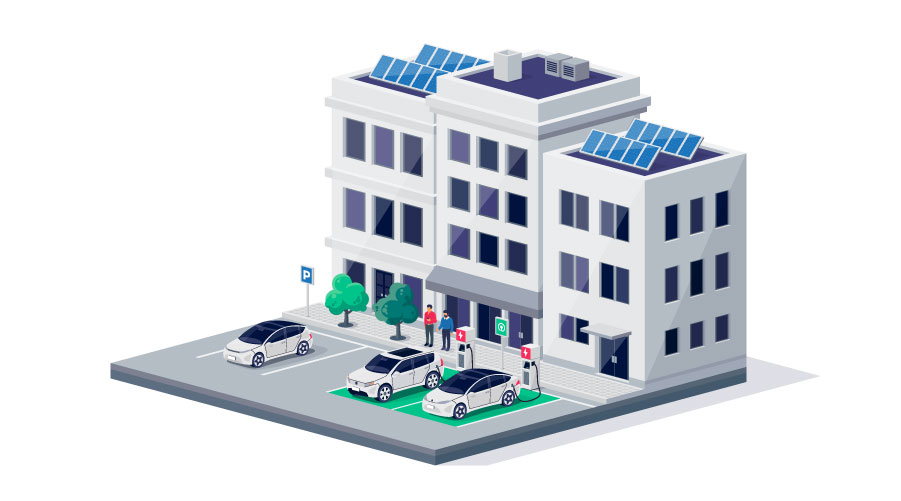Understanding Load Management Systems for EV Charging Infrastructure
Adding EV charging at commercial facilities requires careful planning. Here’s what you need to know about code considerations, load management, and more.
By Robert Lahue, Contributing Writer
As the adoption of electric vehicles (EV) continues to accelerate, facility owners, managers, and engineers are tasked with providing solutions to accommodate more EV chargers. To prepare for this increased electrical demand, several factors should be considered:
- The magnitude of EV loads designers should expect
- Capabilities of EV load management systems
- How the National Electrical Code (NEC) addresses EV load management
- Future considerations for effective system designs
To understand the scale of this challenge, consider this (fictitious) example: Parking Inc. is developing a new 1,000-space parking garage in Chicago, Illinois. The developer estimates approximately 5 percent of customers will drive EVs to the garage and will require charging stations.
The developer engages an architect and engineer to design the building. Using the developer’s estimates, the engineer calculates a bulk load of 415kW for 50 Level 2 AC charging circuits (assume each draws 8.3kW). That is 1,152A on a 208/120V 3PH service and could be served from a single 1,600A switchboard (Note that NEC 2023, article 625.42 defines EV Chargers as continuous loads). A significant load, but not insurmountable.
During the team’s due diligence review, the engineer identifies a requirement previously unknown to the developer: the Chicago Energy Transformation Code (CETC) requires that at least 20 percent of parking spaces be EV-ready or EV-installed. Instead of 50 parking spaces, the electrical service(s) will need to be able accommodate chargers for 200 parking spaces and capacity for 1660kW of EV chargers (just over 4600A at 208/120V 3PH).
Ideally, infrastructure can be provided to fully accommodate all EV parking spaces. However, designing for the entirety of the connected load will require multiple services and switchboards, which could become cost- and space-prohibitive. It may be time to consider a load management strategy for the EV charging infrastructure.
Capabilities of EV Load Management Systems
To tackle a project like the one described above, the goals with EV load management are:
- Safely limit the overall EV power draw on the system so that it does not exceed the building infrastructure capacity.
- Efficiently balance and distribute charging power to consumers.
Energy Management Systems (EMS) achieve these goals by applying static and dynamic load management techniques to control EV charging power. For example, a system could limit the total EV charging load based on the electrical service size (static load management), and then automatically distribute power to individual EV chargers based on the quantity of cars charging and their battery levels (dynamic load management). This application lends itself well to the parking garage scenario described above. The EMS could be programmed with an upper limit of 415kW on the main service, and automatically adjust charging rates accordingly on a first-come, first-serve basis.
This looks like a viable solution for our parking garage example, but many engineers may express some hesitancy. Does this mean a system could be safely designed for installing 1660kW of EV chargers on an electrical service rated only for 415kW? Let’s see what the NEC has to say.
The NEC on Electric Vehicle Supply Equipment (EVSE) and Load Management Systems
Current versions of the NEC (2020, 2023) provide some guidance on the use of load management for sizing EV infrastructure, but it is loosely defined. Articles 625 and 750 offer flexibility for sizing EV infrastructure with two important caveats:
- Most of the responsibility is placed on the load management system technology, and therefore the manufacturers and engineers who develop and specify these systems.
- The language in these code sections is written with the implication of an on-premises load management system, whereas many manufacturers have developed cloud-based solutions.
Keep these considerations in mind as we take a closer look at NEC articles 625 and 750.
NEC 625 broadly addresses two methods for load management control and permits those systems to dictate the size of the electrical infrastructure serving the EV chargers. Both methods reference article 750.30 for Energy Management Systems.
NEC 750.30 has been expanded in the 2023 edition and identifies several requirements for an EMS used in this application. Engineers must thoroughly consider how these requirements will be met, and should be able to answer these questions:
- Does the EMS or adjustable EVSE have a fail-safe feature? NEC 750.30(C)(2) requires the system to automatically cease current flow upon failure or malfunction.
- Does the EMS require a subscription-based license? If the license is not renewed, could the EV chargers lose the constraints previously enforced by the EMS, thereby exposing the electrical system to risk of overload?
- Who will have access to the EMS or adjustable EVSE? Adjustable settings are only permitted if access to the settings is limited to only qualified personnel.
- Is the EMS or adjustable EVSE controlled and operated on-premises, or does it require cloud-based communication? The NEC offers little clarification on this, and some interpretations may conclude that the load management system should be contained on-premises.
The EVSE marketplace is developing a variety of solutions to meet both methods addressed by NEC 625. For EVSE with adjustable trip settings, many products have a manually adjustable means within the EVSE enclosure (e.g., dip switches) as a basic form of static load control. Some system configurations employ the use of “smart” circuit breakers, which have the EVSE integrated into a circuit breaker and allow the EVSE output and overcurrent protection to be adjusted together.
For the energy management system approach, many providers have equipped their EVSE with communications to interface with a cloud-based energy management system. Load control is performed through software, which can apply both static and dynamic load management strategies.
Present and Future Design Considerations
Engineers, architects, and developers should proceed with caution when designing EV systems that will rely on a load management system. These are exciting advancements in the industry, but the technology and applications of EMS and EVSE are still very new. Codes and standards are racing to catch up with public demand and manufacturer solutions, leaving potential gaps in terms of safety and security. Below are several considerations we encourage industry professionals to review and discuss:
- To date, there is not a specific UL or NRTL listing that applies to an automatic EVSE load management system. How will third-party testing organizations vet and test these systems?
- Does the NEC restrict the use of cloud-based automatic load management systems? It is not clear, and at least should be discussed with the AHJ.
- What are the cyber security risks? For new communication protocols under development such as the Open Charge Point Protocol (OCPP), what measures have been taken to ensure security?
- Who will have access to manage these systems? If an unauthorized person gains access to the system, could they remove maximum current limits and put the system at risk of overloading?
Finally, it is imperative to review the latest technologies and information available before incorporating into a new project design. Facility longevity will improve with solutions that can adapt to evolving codes, standards, and technologies, and with trusted vendors who will continue to support their products in the future. Despite our cautionary nature as engineers, we are very excited about the future of these technologies and look forward to working with the industry to answer these questions.
Robert Lahue, PE, CDT, is an electrical project engineer with ESD, a leading global engineering firm specializing in mechanical, electrical, plumbing, fire protection, life safety, structural, and technology engineering. Lahue is responsible for assisting with BIM design, specifically for lighting and power systems.
Related Topics:












